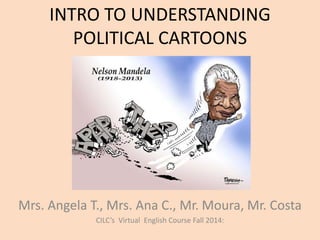
Intro to-political-cartoons-1221750370250489-9
- 1. INTRO TO UNDERSTANDING POLITICAL CARTOONS Mrs. Angela T., Mrs. Ana C., Mr. Moura, Mr. Costa CILC’s Virtual English Course Fall 2014:
- 2. What are Political/Editorial Cartoons? • Political cartoons are an art form that serves as a window into history. It shows us what people think and talk about at a given time and place.
- 3. Is this a/an political/editorial cartoon? Does it have a social or political message?
- 4. Uses of Political Cartoon • Presents a particular viewpoint on political, economic, or social issues • Make use of humor, symbolism, historical events, and stereotypes to draw attention to an idea, event, or person • Stimulates debate on an issue How Do I Know what the Cartoon is Saying?
- 5. I -Symbolism • Cartoonists use simple objects, or symbols, to stand for larger concepts or ideas. McDonald Lincon’s Memmorial RepublicanJustice Peace Money The Capitol Democrats UN Pace and Love Post Office Peace and Love Anarchy The White House TerrorrrismNazi
- 6. Other Symbols: • Powerful people are usually fat, large people • Weak people are usually skinny, small people • Green – environmental • Red – communist • Good guys usually wear white • Bad guys usually wear black
- 7. After you identify the symbols in a cartoon, think about what the cartoonist intends each symbol to stand for.
- 9. II. Exaggeration • Sometimes cartoonists overdo, or exaggerate, the physical characteristics of people or things in order to make a point. Therefore, when you study a cartoon, look for any characteristics that seem overdone or overblown. (Facial characteristics and clothing are some of the most commonly exaggerated characteristics.) Then, try to decide what point the cartoonist was trying to make through exaggeration.
- 11. III. Labelling • Cartoonists often label objects or people to make it clear exactly what they stand for. Therefore, watch out for the different labels that appear in a cartoon, and ask yourself why the cartoonist chose to label that particular person or object. Does the label make the meaning of the object more clear?
- 13. IV. Analogy • An analogy is a comparison between two unlike things that share some characteristics. By comparing a complex issue or situation with a more familiar one, cartoonists can help their readers see it in a different light. Therefore, after you’ve studied a cartoon for a while, try to decide what the cartoon’s main analogy is. What two situations does the cartoon compare? Once you understand the main analogy, decide if this comparison makes the cartoonist’s point more clear to you.
- 15. V. Irony • Irony is the difference between the ways things are and the way things should be, or the way things are expected to be. Cartoonists often use irony to express their opinion on an issue. Therefore, when you look at a cartoon, see if you can find any irony in the situation the cartoon depicts. If you can, think about what point the irony might be intended to emphasize. Does the irony help the cartoonist express his or her opinion more effectively?
- 17. VI. Stereotyping Groups of people may be represented in an over-simplified and inaccurate fashion to call attention to them or to the central issue.
- 18. VII. Allusion Political cartoons refer to current events and issues. Consequently, the political cartoon may lose some of its effect with the passage of time.
- 19. VIII. Comparison / Contrast Differences or similarities can be highlighted by placing similar or different items or people together.
- 21. Bibliography http://www.longleaf.net/newsroom101/ http://www.cagle.com http://wikipedia.org/ Special thanks to Mrs. Patty Des Rochers for the tips on analyzing cartoons! http://www.toonpool.com/cartoons/Equilibrazil_202831#img9
- 22. Let’s do some together… ASK YOURSELF: • What issue is this political cartoon about? • What is the cartoonist’s opinion on this issue? • What other opinion can you imagine another person having on this issue? • Did you find this cartoon persuasive? Why or why not? • What other techniques could the cartoonist have used to make this cartoon more persuasive?
- 23. Other steps to help understand Cartoons: • Step One: Say what you can see on the four quadrants • Step Two: Ask questions • Step Three: Determine the target of criticism • Step Four: State in a short declarative sentence the cartoonist’s opinion • Step Five: Decide whether you agree or disagree with the cartoonist.
- 25. Describe what you see in the cartoon. What issue or event inspired the cartoon? What people or objects in the cartoon are symbols? What does each one symbolize? How does the cartoonist use words to clarify the meaning of the cartoon? How does the cartoonist use caricature and/or satire to make a point? What is the message or meaning of the cartoon? (This usually reflects the opinion of the cartoonist.) Do you agree with the cartoonist’s point of view? How effective is the cartoon?
- 29. President Obama Michelle Obama Sarah Palin Gov. Perry
- 33. Symbols
- 35. Other Symbols: US Politics Democrats – donkey Republicans – elephant US politics – capitol building
- 36. United Kingdom John Bull – a fat person in tailored suit - Lion Saudi Arabia
- 37. Russia bear EU
- 39. Japan Kimono, slanted eyes, sumo wrestler, Mt. Fuji
- 41. Symbols Female & male Pork barrel – waste Money Communism justice
- 43. Religions
- 44. Liberty, freedom and democracy: Torch Liberty Bell Statue of Liberty
- 45. Peace and War Peace – dove, laurels, peace fingers or peace sign War – hawk, bomb, missiles
- 46. Time and Victory Time – clock or hourglass Victory – victory fingers, trophy, or wreath of laurels
- 47. Death & Danger -Falling objects -Vultures -Scull & crossbones -cliffs
- 48. Slow – snail, turtle Love – heart, cupid, venus Hope – rainbow, smiley Wealth – money bags
- 50. Common Symbols: USA Uncle Sam or Eagle
